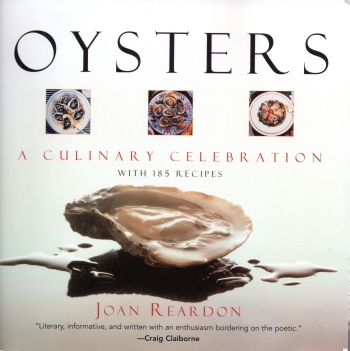A note on steak & oyster tartare, with a recipe.
If the 1950s surf & turf of steak and lobster is an abomination, it also is aberrant. Lots of seafood works well with certain meats. Pork in particular pairs with both shell and finned fish; chowder without salt pork is inconceivable, bacon turns the oyster into an angel on horseback and prociutto or even dry cured country ham wraps cod, hake or halibut. Beef has its marine uses too, and if there are considerably fewer of them, they also can sing. A carpetbagger steak stuffed with oysters and sauced with Bordeliase does not taste as odd as it sounds: It is worth remembering that oysters elevate a traditional steak and kidney pudding too.
It therefore strikes the Editor that oysters added to streak tartare is such a rarity. Nothing beats a good raw oyster, and anyway beef benefits from a hit of salt. None of us at britishfoodinamerica ever has found the dish on a restaurant menu, and we only ever have seen the recipe once in print. It does not even surface on the infinite ether of the internet.
The source of our enlightenment is an otherwise uninspiring book, Oysters: A Culinary Celebration by Joan Reardon (Guilford CT 2004). It is all a bit of a tease. While Oysters purports to survey the history of oyster recipes across time and space, she seldom discloses her sources.
Reardon describes the hybrid tartare as ‘A Gentleman’s Dish’ that, “like ‘private stock’ is only for the few,” but why? She calls it “[d]ecidedly decadent but not altogether disreputable” and “ideal for lunching in pub or club with a tall cool glass of Pilsner at the ready” in her typically icky prose. She neither identifies the origin of her recipe nor any pub or club that serves the dish, and in fact its components are neither laden with calories nor saddled by cost; a little goes a long way.
The recipe itself is not quite right in her hands, so trust ours instead.
Steak tartare with oysters. Do not scrimp on the quality of beef that you select for this preparation. Tenderloin is best, for a change; sirloin will do. Four servings.
 -1 lb beef, cut into the tiniest dice
-1 lb beef, cut into the tiniest dice
-about 2 Tablespoons capers
-about 1 Tablespoons minced parsley
-2-3 minced scallions
-a minced shallot
-about 2 teaspoons Worcestershire
-splash hot sauce
-a beaten egg
-salt and pepper
-16 oysters
-4 hefty wedges of lemon
- Gently fold together the beef, capers, parsley, scallions, shallot, Worcestershire and hot sauce.
- Gently bind the mixture with the egg and season it with salt and pepper.
- Divide the steak tartare in four, top each portion with four of the oysters.
- Serve the tartare with the lemon wedges and lots of toast (restaurants seldom provide enough for this sort of thing) or water crackers.
Notes:
- Some people prefer the texture of raw ground to chopped beef, and grinding the meat, or buying it ground, certainly makes the recipe easier. You also can get away with a less expensive cut, even flavorful chuck. If, however, you do not grind your own meat, ensure that you buy it very fresh indeed from a reputable butcher to diminish the risk of illness. Better yet, watch the butcher actually grind the meat.
- The proportions of just about everything in the tartare may be altered to suit your own whim or the taste of your guests. This recipe is like the Pirate Code, more a guideline than a rule.
- Reardon chops her oysters finely and mixes them up with the rest of the ingredients, which also makes a nice tartare.

